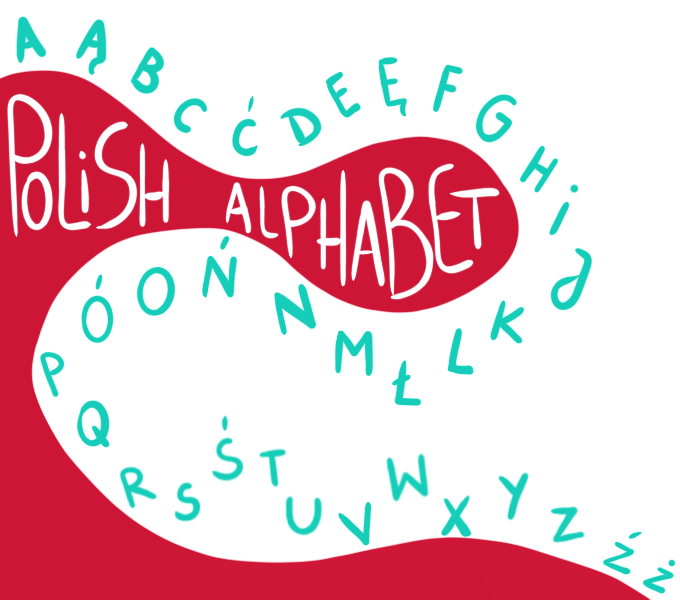Guide to Polish Alphabet with Pronunciation
April 4, 2022 2023-11-19 12:21Guide to Polish Alphabet with Pronunciation
ABECADŁO – the POLISH LANGUAGE ALPHABET
It is not a secret that Polish language is a difficult one to learn. Even Polish native speakers make mistakes. As the Polish alphabet has more letters than the English one and the pronunciation is not easy, learning Polish alphabet may be challenging for the foreigners.
Our task for today is to make it easier for you to learn the Polish alphabet and the right pronunciation.
The most important information about the Polish alphabet:
- ABECADŁO is a different name for the ALPHABET.
- It is based on the Latin alphabet.
- It has 6 more letters than the English alphabet.
- It contains 9go intriguing characters:
Ą, Ć, Ę, Ł, Ń, Ó, Ś, Ź, Ż

Today we will focus on the Polish alphabet and its letters.
Look at that sentence. This is a pangram. It contains all of the Polish letters!
Pójdźże kiń tę chmurność w głąb flaszy.
*English example of a pangram:
The quick brown fox jumps over the lazy dog.
PRONUNCIATION IN POLISH ALPHABET
It’s time to focus on the right pronunciation of the letters which are in the Polish alphabet.
| (English equivalent) | ||
| A (a) | /ä/ | large |
| Ą (ą) | /ɔ̃/ | denouement; nasal o |
| B (b) | /b/ | bed |
| C (c) | /t̪͡s̪/ | pits |
| Ć (ć) | /t͡ɕ/ | chips |
| D (d) | /d̪/ | door |
| E (e) | /ɛ/ | bell |
| Ę (ę) | /ɛ̃/ | nasal e; slightly lengthened e |
| F (f) | /f/ | four |
| G (g) | /ɡ/ | go |
| H (h) | /x/ | hike |
| I (i) | /i/ | feet |
| J (j) | /j/ | yellow |
| K (k) | /k/ | key |
| L (l) | /l/ | lollipop |
| Ł (ł) | /w/ | will |
| M (m) | /m/ | more |
| N (n) | /n̪/ | night |
| Ń (ń) | /ɲ̟/ | canyon |
| O (o) | /ɔ/ | dog |
| Ó (ó) | /u/ | good |
| P (p) | /p/ | parrot |
| R (r) | /r/ | similar to the sound written as R in many languages |
| S (s) | /s̪/ | snake |
| Ś (ś) | /ɕ/ | sheep |
| T (t) | /t̪/ | start |
| U (u) | /u/ | food |
| W (w) | /w/ | vow |
| Y (y) | /ɘ̟/ | bit |
| Z (z) | /z̪/ | zebra |
| Ź (ź) | /ʑ/ | vision (alveolo-palatal) |
| Ż (ż) | /ʐ/ | vision |
The Polish language also has 7 digraphs.
Let us take a look at their pronunciation.
| CH | halloween |
| CZ | challenge |
| DZ | lads |
| DŹ | jealous |
| DŻ | adjust |
| RZ | treasure |
| SZ | shadow |
LETTERS AND EXAMPLES IN POLISH ALPHABET
Let’s take a closer look at the Polish alphabet and the letters when they appear:
- at the beginning,
- in the middle
- and at the end of the words.
(some letters do not appear in all 3 cases)
| A (a) | ALFABET | PORANEK | KORONA | /alphabet, morning, crown |
| Ą (ą) | BRĄZOWY | CHCĄ | /brown, they want | |
| B (b) | BIEGAĆ | GRABIE | KLUB | /to run, rake, club |
| C (c) | CUKIEREK | PRACA | KAC | /candy, job, hangover |
| Ć (ć) | ĆMA | ZAĆMA | IŚĆ | /moth, cataract, to go |
| D (d) | DOM | BUDOWAĆ | GRAD | /house, to build, hail |
| E (e) | EKIERKA | WIEM | NIE | /set square, I know, not |
| Ę (ę) | FALA | GĘSTY | LUBIĘ | /thick, I like |
| F (f) | FALA | RAFA | KLIF | /wave, reef, cliff |
| G (g) | GÓRY | MOGĘ | RÓG | /mountains, I can, horn |
| H (h) | HAK | BOHATER | DRUH | /hook, hero, comrade |
| I (i) | IGŁA | MIŁY | DRZWI | /needle, nice, door |
| J (j) | JABŁKO | PAJĄK | MÓJ | /apple, spider, my |
| K (k) | KOLOR | POLSKI | JAK | /colour, Polish, how |
| L (l) | LODY | MALINA | BAL | /ice cream, raspberry, ball |
| Ł (ł) | ŁÓDŹ | MAŁY | WAŁ | /boat, small, embankment |
| M (m) | MATKA | KAMIEŃ | DAM | /mother, stone, I will give |
| N (n) | NOC | MANIAK | KOKON | /night, maniac, cocoon |
| Ń (ń) | /ɲ̟/ | SŁOŃCE | WOŃ | /sun, aroma |
| O (o) | OKULISTA | MORZE | DZIECKO | /oculist, sea, child |
| Ó (ó) | ÓSMY | BÓL | /8th, pain | |
| P (p) | PALEC | GŁUPI | TELESKOP | /finger, stupid, telescope |
| R (r) | ROBIĆ | BARDZO | DAR | /to do, very, gift |
| S (s) | SUKIENKA | MASAŻ | MUS | /dress, massage, mousse |
| Ś (ś) | ŚLIWKA | MAŚĆ | KTOŚ | /plum, ointment, somebody |
| T (t) | TAK | PŁYTA | KOT | /yes, disc, cat |
| U (u) | UL | KULA | TABU | /hive, sphere, taboo |
| W (w) | WIR | ZABAWKA | KREW | /moil, toy, blood |
| Y (y) | YETI | DYM | PALMY | /yeti, smoke, palms |
| Z (z) | ZEBRA | DZWONEK | RAZ | /zebra, bell, once |
| Ź (ź) | ŹREBAK | DŹWIG | MAŹ | /foal, crane, slime |
| Ż (ż) | ŻABA | WAŻKA | JEŻ | /frog, dragonfly, hedgehog |
DIFFERENCES IN POLISH LANGUAGE
Let’s look at the most important differences between the English and Polish alphabet and try to learn them.
- The Polish language has 8 vowel sounds.
- The English language has 22 vowel sounds.
- There is no English equivalent of any of the Polish vowels.
- The Polish language has no weak vowels.
- Polish words with double consonants are difficult to pronounce for English speakers, as they tend to treat them as one consonant. /horror, lasso…/
TEST YOUR TONGUE WITH POLISH LANGUAGE
Before you start, look at the Polish alphabet once again and try to remember the right pronunciation.
TASK 1.
Read the lines 4 times, starting slowly and ending up reading them as fast as you can.
Ą Ą Ć R Ą Ą Ć R Ą Ą Ć R Ą Ą Ć R Ą Ą Ć R
K C G G K C G G K C G G K C G G K C G G
Z Ź Ż Y Z Ź Ż Y Z Ź Ż Y Z Ź Ż Y Z Ź Ż Y
U O Ó W U O Ó W U O Ó W U O Ó W
B P P T B P P T B P P T B P P T B P P T
Ś S E I Ś S E I Ś S E I Ś S E I Ś S E I Ś S E I
TASK 2.
Play your favourite song and try to sing the Polish alphabet to its melody.
(Don’t miss this task, we can hear you;) )
TASK 3.
Solve a test in order to check if you remember the most important information about the Polish alphabet and the right pronunciation.
- ………………………….. is a different name for ALPHABET.
• Abecede
• Abecadło
• Abededeło
- The Polish alphabet ……..is based on the Latin alphabet.
• Is
• Isn’t
- Which letters have the same pronunciation?
• S and Ś
• U and Ó
• Ż and Ź
- Which sentence is correct?
• The Polish language has 8 vowel sounds and the English language has 23 vowel sounds.
• The Polish language has 6 vowel sounds and the English language has 22 vowel sounds.
• The Polish language has 8 vowel sounds and the English language has 22 vowel sounds.
• The Polish language has 6 vowel sounds and the English language has 23 vowel sounds.
- The Polish language has no weak vowels.
• true
• false
Mastering the Polish Language Alphabet: Your Gateway to a Rich Linguistic Heritage
Embarking on the journey to learn the Polish language alphabet is the first step in unlocking the door to a rich and expressive language. The Polish language alphabet, a fundamental aspect of the language, is not just a set of letters but a bridge to understanding Poland’s culture and history.
Understanding the Polish Language Alphabet
The Polish language alphabet is based on the Latin script, with a few additional characters that give it its unique sound and rhythm. These special characters in the Polish language alphabet are crucial for accurate pronunciation and meaning. For learners, getting acquainted with these characters is essential in mastering the language.
The Uniqueness of the Polish Language Alphabet
What sets the Polish language alphabet apart are the specific diacritical marks that modify the pronunciation of certain letters. These marks in the Polish language alphabet, such as the kreska (acute accent) and ogonek (tail), are unique to Polish and some other Slavic languages, adding a layer of complexity and distinctiveness to the language.
Learning the Polish Language Alphabet: Tips and Strategies
To effectively learn the Polish language alphabet, it is recommended to start with the basics – familiarizing yourself with the pronunciation of each letter and letter combination. Resources such as online tutorials, alphabet charts, and language learning apps can be invaluable in this journey. Regular practice, including listening to Polish speech, reciting the alphabet, and writing out the letters, helps in embedding the Polish language alphabet in your memory.
The Importance of the Polish Language Alphabet in Communication
A firm grasp of the Polish language alphabet is not just about reading and writing. It’s about understanding the nuances of the language, engaging in clear communication, and appreciating the linguistic richness of Polish literature and media.
Conclusion: Embrace the Polish Language Alphabet
Learning the Polish language alphabet is an enriching experience, opening up new avenues for cultural exploration and personal growth. Whether you are a language enthusiast, someone with Polish heritage, or a traveler to Poland, mastering the Polish language alphabet is a rewarding and essential part of your linguistic journey.














